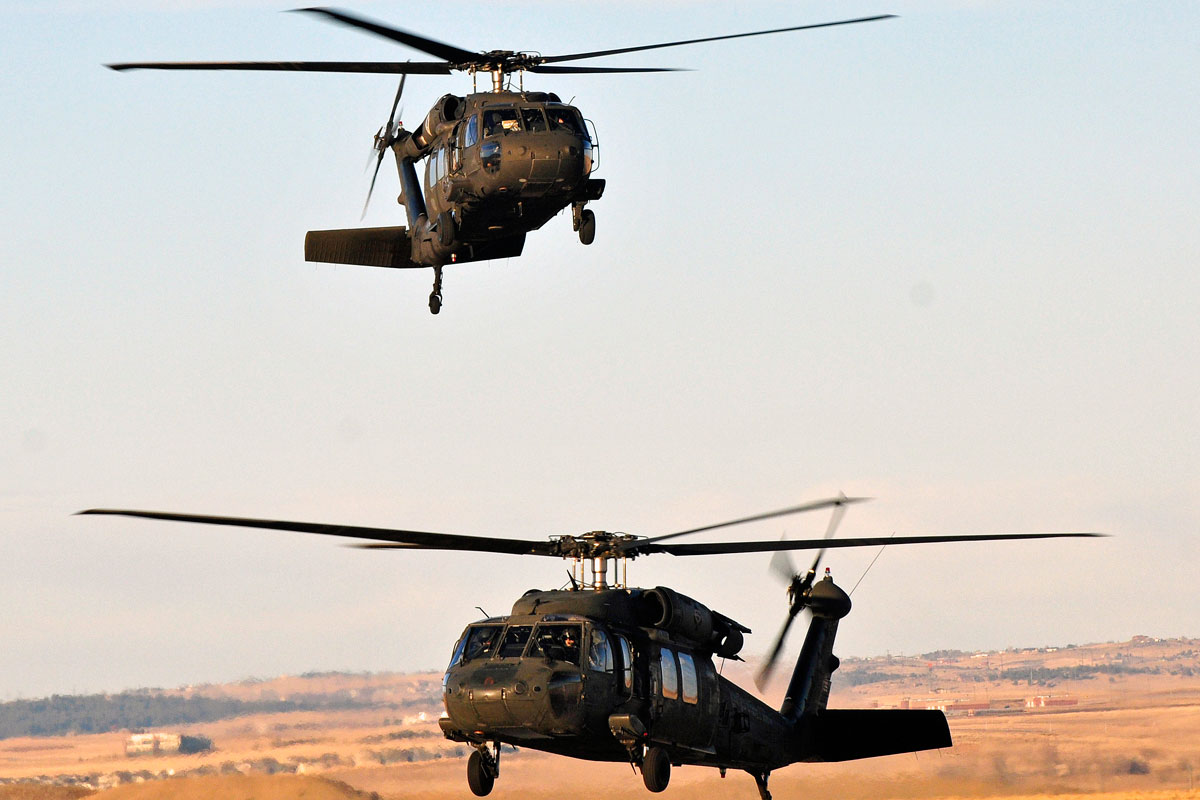Not known Factual Statements About Uh-60
Wiki Article
More About Uh-60
Table of ContentsUh-60 Can Be Fun For EveryoneThe Main Principles Of Uh-60 Getting My Uh-60 To WorkThe 7-Minute Rule for Uh-60
helicopter elements Most helicopters the engine transforms a shaft that links to an input quill on the transmission; the primary rotor mast comes right out of the top of the transmission as well as the tail rotor driveshaft links to an output quill 90 degrees of the mast. Rotating the rotor which has an aero foil section creates lift, allowing the helicopter to climb up and down or float.There are lots of terms linked with rotating wing flight and it is essential for a student to become accustomed to them to comprehend the auto mechanics of rotating wing trip. The main rotor blade carries out the same function as a plane's wings, offering lift as the blades rotate lift being just one of the crucial wind resistant pressures that keeps aircraft up.

Equally as it carries out in a motor automobile, a helicopter's transmission transfers power from the engine to the main and tail blades. The transmission's primary gearbox steps down the speed of the main rotor so it doesn't revolve as swiftly as the engine shaft. A second gearbox does the exact same for the tail rotor, although the tail blades, being much smaller sized, can rotate faster than the primary blades.
Not known Facts About Uh-60
Early helicopters counted on reciprocating gasoline engines, however contemporary helicopters use gas generator engines like those located in industrial airplanes. uh-60. 1. Origin: The internal end of the blade where the rotors attach to the blade grasps. 2. Blade Grips: Huge attaching factors where the blades blade connects to the hub.Doing this enhances or lowers the lift that the main rotor materials to the vehicle, allowing the helicopter to acquire or lose altitude. This allows the helicopter to relocate in any instructions around a 360-degree circle, consisting of ahead, backward, left and also.
Helicopters need an entirely various technique of control than aircrafts and also are much tougher to master. Flying a helicopter calls for constant focus by the pilot and also a near-continuous flow of min control corrections. A standard helicopter has its major rotor over the fuselage, just aft of the cockpit location, being composed of 2 or even more rotor blades expanding out from a main rotor head, or hub, setting up.
This swashplate consists of one non-revolving disc and one rotating disc mounted directly on the useful content top. The swashplate is attached to the cockpit control stick and also bar and also can be made to turn in any type of instructions, according to the cyclic stick motion made by the pilot, or went up and also down according to the cumulative lever activity.
The Only Guide for Uh-60
The quantity of lift created is identified by the pitch angle (and also rate) of each blades blade as it relocates with the air. Pitch angle is recognized as the Angle of Assault when the rotors are in movement. This pitch angle of the blades is controlled in two methods collectively as well as cyclically.
Since all blades are changing pitch with each other, or 'collectively', the adjustment in lift remains constant throughout every complete turning of the blades. Consequently, there is no propensity for the helicopter to transform its existing instructions other than right up or down. The images below reveal the effect of increasing the collective lever on the swashplate and rotor blades.
Certainly, actual rotor head systems are even more complicated than this photo shows, however the basics are the same. The cyclic control is made by relocating the control stick that rises from the cabin floor in between the pilot's legs, as well as can be relocated all directions apart from backwards and forwards.
Uh-60 - The Facts

The illustrations below show the impact of this cyclic control on the swashplate and rotor blades. As the swashplate is tilted, the opposing rods move in opposite directions. The setting of the rods as well as thus the pitch of the private blades is different at any kind of given point of turning, therefore generating various quantities of lift around the blades disc.
As the stick is leaned over in any type of instructions, so the angle of the plate modifications really a little. uh-60. This change of angle matches straight to what is happening to the rotor disc at the very same time i. e. the side of home plate that is higher stands for the side of the rotor disc creating more lift.
This tail blades is used to regulate the yaw, or turning, of the helicopter (i. e. which means the nose is aiming) and to clarify this we initially need to understand torque. Torque is a natural pressure triggered by any kind of turning object and in a helicopter it is caused by the engine turning the main rotor blades; when the blades are spinning then the all-natural reaction to that is for the fuselage of the helicopter to start rotating in the opposite direction to the blades.
Report this wiki page